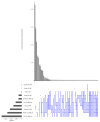The EpiDiverse Plant Epigenome-Wide Association Studies (EWAS) Pipeline
- PMID: 34968299
- PMCID: PMC8594691
- DOI: 10.3390/epigenomes5020012
The EpiDiverse Plant Epigenome-Wide Association Studies (EWAS) Pipeline
Abstract
Bisulfite sequencing is a widely used technique for determining DNA methylation and its relationship with epigenetics, genetics, and environmental parameters. Various techniques were implemented for epigenome-wide association studies (EWAS) to reveal meaningful associations; however, there are only very few plant studies available to date. Here, we developed the EpiDiverse EWAS pipeline and tested it using two plant datasets, from P. abies (Norway spruce) and Q. lobata (valley oak). Hence, we present an EWAS implementation tested for non-model plant species and describe its use.
Keywords: DNA methylation; EWAS; GWAS; non-model species; pipeline; plant epigenetics.
Conflict of interest statement
The authors declare no conflict of interest.
Figures






References
Grants and funding
LinkOut - more resources
Full Text Sources

